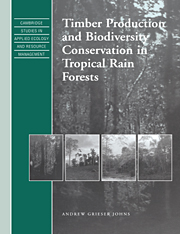Book contents
- Frontmatter
- Contents
- Foreword
- Preface
- Explanatory note
- 1 The issues
- 2 The history and development of tropical forestry
- 3 Changes in the physical environment
- 4 Forest regeneration and gap dynamics
- 5 Responses of individual animal species
- 6 Responses of species assemblages
- 7 Using ecological data in forest management planning
- 8 Intervention to maintain biodiversity
- 9 Field procedures
- 10 The future
- References
- Subject index
7 - Using ecological data in forest management planning
Published online by Cambridge University Press: 04 December 2009
- Frontmatter
- Contents
- Foreword
- Preface
- Explanatory note
- 1 The issues
- 2 The history and development of tropical forestry
- 3 Changes in the physical environment
- 4 Forest regeneration and gap dynamics
- 5 Responses of individual animal species
- 6 Responses of species assemblages
- 7 Using ecological data in forest management planning
- 8 Intervention to maintain biodiversity
- 9 Field procedures
- 10 The future
- References
- Subject index
Summary
Introduction
The application of ecological data on the effects of timber logging on biodiversity to forest planning and in situ forest management is at a very early stage of development. There are two principal reasons for this.
First, the level of training of forestry staff in many tropical countries is often very low (Palmer & Synnott 1992). Field staff often lack basic technical manuals: research is outdated and poorly disseminated. Staff are not familiar with the range of forest management techniques at their disposal and have very little knowledge or appreciation of the relevance of biodiversity conservation. Even if basic principles of biodiversity conservation are included within national forest planning strategies, to be applied effectively these require both research programmes to determine specifically the type and extent of any interventions required and training of forestry staff to implement them.
Second, research studies of the effects of timber logging on biodiversity have generally not collected data in a form that can be applied to in situ forest management. Most research has been academically oriented with the implications for forest management considered only after the study has been completed. The design of most field studies has been particularly limiting: most are short-term comparisons of sites of different logging histories. To make an effective contribution to forest management planning, studies need to be long-term and directed towards the identification of cost-effective techniques for enhancing the biological value of regenerating forest.
This chapter considers the reliability of information produced by different types of ecological study and their potential contribution to forest management practice. The next chapter considers the forms of intervention that might be applied.
- Type
- Chapter
- Information
- Publisher: Cambridge University PressPrint publication year: 1997



